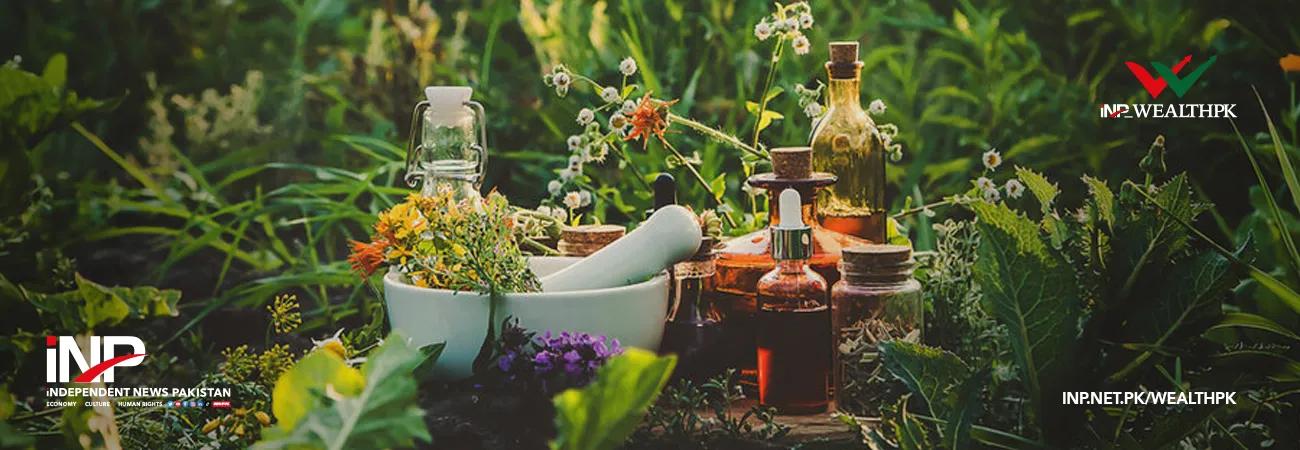i INP-WEALTHPK
Azeem Ahmed Khan
Pakistan is home to a number of unique plant species found nowhere else in the world, but many of these have disappeared due to poor government policies and lack of care.

This was stated by former director of biodiversity, Pakistan Forest Institute (PFI), Dr Chaudhry Muhammad Muslim, while talking to WealthPK. Lamenting that Pakistan has failed to preserve its rich plant diversity over short-term financial gains, he urged authorities concerned to take immediate action for protecting these valuable resources.
He has suggested that the forest department should protect high-value hilly herb-rich regions such as Swat, Dir, and Leepa and Neelam valleys in Azad Jammu and Kashmir by fencing them off to allow medicinal plants to thrive and prevent grazing. He has also demanded formation of a conservation policy to safeguard these precious plants.
Dr Muslim has also emphasised the need to enhance the processing quality of Pakistani herbs for value addition to compete in the $251 billion global herbal medicine market. Having spent over 30 years researching medicinal plants, Dr Muslim recalled designating conservation areas in Kooza Gali, Bhurban, Kalam, Dera Ismail Khan, and Peshawar with the provincial government’s support.
However, he expressed disappointment that these areas were neglected after his retirement from service. He observed deliberate forest fires – often set to cover up timber theft – have contributed to the destruction of these plants, while adversely impacting both flora and wildlife too. Additionally, climate change has posed a new challenge by altering snowfall and rainfall patterns and causing many plants to wither and die, he added.
Despite these setbacks, Pakistan still possesses over 100 valuable medicinal plants with significant economic potential, Dr Muslim said. He pointed out that countries like China and India earn substantial foreign exchange by properly growing herbs and establishing modern processing units. He pointed out that Pakistan has an abundance of menthol and banafshah, both essential for medicinal production.
However, improper drying and packaging methods hinder their marketability, he added. While Peshawar has dedicated government departments, such as the Non-Timber Forest Produce Division, to protect medicinal plants, no such initiatives exist in Punjab, Sindh, or Balochistan provinces, he noted. Over the years, Pakistan has lost several plant species, he noted. For instance, Balochistan once had Ephedra Nebrodensis, used for making ephedrine and treating respiratory issues, but it has also vanished now, he added.
He said that Trillium, a plant once found in abundance, was smuggled to India, where its roots were used for making injections to stop bleeding. Another plant, Saussurea costus, was so valuable that British authorities had banned its uprooting. However, officials in Azad Jammu and Kashmir later sold it in large quantities, he regretted. Pakistan also lost wild mint due to reckless uprooting instead of sustainable harvesting, while other plants like Sweet Violet, Shronjaan, and Safaid Mosli met the same fate, he said.
Podophyllum, which was widely used for treating liver cirrhosis, was overharvested to the point of extinction and is now on the red list, he added. Highlighting Pakistan’s rich botanical diversity, Dr Muslim cited Jogi Badshah, a rare herb that grows at 14,000 feet in Babusar Top region, where winter temperature drops to -19 degrees centigrade. “This plant’s roots can cure pneumonia within days.” He stressed the economic potential of Pakistan’s medicinal plants, provided quality control is improved.
He has urged the government to ensure that the quality of medicinal herbs is not compromised by adulterators, so their domestic and international marketing is not hurt. Adulteration has damaged the reputation of Pakistani herbal products domestically and internationally. For instance, Tukhm Balanga in the local market is often mixed with Niazbo and Tulsi seeds, he claimed. Pakistan even imports herbs like chamomile and Ispaghol, despite having local supplies, he noted.
Dr Muslim claimed that Pakistani Ispaghol is artificially whitened using zinc, which is harmful to health, so people prefer to buy the imported one. The country also produces Malathi in Chitral and Balochistan, yet Afghan Malathi is preferred due to its superior thickness, he pointed out. Similarly, saffron sells for Rs800,000 per kg in Pakistan, but local suppliers often sell artificially dyed maize hair as saffron, he added.
Pakistan produces large quantities of Tribulus (Bakhra), a seed with medicinal value, yet only the Indian variety is sold in the United Kingdom, Dr Muslim said. Milk thistle, used for treating hepatitis B and C, is readily available but is often imported due to concerns over local processing quality, he added.
According to Dr Muslim, some of the most widely used medicinal plants in Pakistan include: Neem, known for its antibacterial and healing properties; Aloe Vera, used for skincare and digestion; Giloy, used to boost immunity; Senna, a natural laxative; Black Seed, supports digestion and diabetes management; Henna, commonly used for hair and skin care, Turmeric, has anti-inflammatory properties; and Moringa, super food rich in nutrients.
These plants are either harvested from the wild or cultivated by farmers and then sold, he added.
Credit: INP-WealthPk




